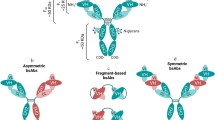Abstract
Objective: To construct and express a human-mouse chimeric antibody against human bladder cancer. Method: The variable region genes of anti-human bladder cancer monoclonal antibody BDI-1 were cloned by RT-PCR. A human-mouse chimeric antibody expression vector was constructed and transfected into CHO cells. The chimeric antibody against bladder cancer was expressed and characterized. Result: Eukaryotic expression vector of the chimeric antibody against human bladder carcinoma was successfully constructed, and was expressed in eukaryotic cells; the expressed chimeric antibody ch-BDI showed same specificity as its parent McAb against human bladder cancer cells. Conclusion: The constructed chimeric antibody was expressed successfully in eukaryotic cells, and the chimeric antibody had desired affinity against human bladder cancer cells.
Similar content being viewed by others
References
Kim HL, Steinberg GD. The current status of bladder preservation in the treatment of muscle invasive bladder cancer[J]. J Urol 2000; 164: 627.
Lamm DL, Allaway M. Current trends in bladder cancer treatment[J]. Ann Chir Gynaecol 2000; 89:234.
Agus DB, Bunn PA Jr, Franklin W, et al. HER-2/neu as a therapeutic target in non-small cell lung cancer, prostate cancer, and ovarian cancer[J]. Semin Oncol 2000; 27:53.
Goker H, Haznedaroglu IC, Chao NJ. Acute graft-vs-host disease: pathobiology and management[J]. Exp Hematol. 2001; 29:259.
Syrigos KN, Pliarchopoulou K, Harrington KJ. The development of monoclonal antibody therapy in leukemias[J]. Hybridoma 2001; 20:145.
Yu LiZhang, Gu Fangliu, Zhang Chunli, et al. Targeted diagnosis and treatment of superficial bladder cancer with monoclonal antibody BDI-1[J]. Chin Med J 1998; 111: 404.
Zhang Chunli, Yu LiZhang, Zhao Chong, et al. 131I-bladder carcinoma monoclonal antibody for immunotherapy in tumor bearing mice[J]. Chin J Urol 1994; 15: 3.
Yu LZ, Gu FL, Xie SS, et al. Construction and expression of single chain Fv antibody against human bladder carcinoma[J]. Urol Res 1996; 24: 273
Li Jing, Wang Yan, Wang ZhuoZhi, et al. Construction and expression of anti-human stomach tumor human-mouse chimeric antibody[J]. J Chin Cancer biother 1998; 5: 116.
Metts MC, Metts JC, Milito SJ, Thomas CR Jr. Bladder cancer: a review of diagnosis and management[J]. J Natl Med Assoc 2000; 92:285.
Vaswani SK, Hamilton RG. Humanized antibodies as potential therapeutics[J]. Allergy Asthma Immunol 1998; 81:105.
Co MS, queen C. Humanized antibodies for therapy[J]. Nature 1991; 351: 501.
Chintalacharuvu KR, Morrison SL. Chimeric antibodies: production and applications[J]. Methods: A companion to Methods in Enzymol 1995; 8: 73.
Bending MM. Humanization of rodent monoclonal antibodies by CDR grafting[J]. Methods: A companion methods in Enzymol 1995; 8: 83.
Jespers LS, Roberts A, Mahler SM, et al. Guiding the selection of human antibodies from phage display repertoires to a single epitope of an antigen[J]. BioTechnol 1994; 12: 899.
Mersmann M, Schmidt A, rippmann JF. Human antibody derivatives against the fibroblast activation protein for tumor stroma targeting of carcinomas[J]. Int J Cancer 2001; 92: 240.
Emre S, Gondolesi G, Polat K, et al. Use of daclizumab as initial immunosuppression in liver transplant recipients with impaired renal function[J]. Liver Transpl 2001; 7:220.
Heinzerling L, Dummer R, Kempf W, et al. Intralesional therapy with anti-CD20 monoclonal antibody rituximab in primary cutaneous B-cell lymphoma[J]. Arch-Dermatol 2000; 136: 374.
Schaller G, Bangemann N, Becker C, et al. Therapy of metastatic breast cancer with humanized antibodies against the HER2 receptor protein[J]. J Cancer Res Clin Oncol. 1999; 125: 520.
Valle E, Gross M, Bickston SJ. Infliximab[J]. Expert Opin Pharmacother 2001; 2:1015.
Greenough A, Thomas M. Respiratory syncytial virus prevention: past and present strategies[J]. Expert Opin Pharmacother 2000; 1:1195.
Dewey D.Y. Ryu, Doo-Hyun Nam. Recent progress in biomolecular engineering[J]. Biotechnol Prog 2000; 16: 2.
Author information
Authors and Affiliations
Corresponding author
Additional information
Foundation item: This work was supported by the National Natural Science Foundation of China(No. 30070706).
Biography: BAI Yin(1971–), doctoral candidate, the First Hospital, Peking University, majors in Urology.
Rights and permissions
About this article
Cite this article
Bai, Y., Wang, Y., Zhou, LJ. et al. Construction and expression of a human-mouse chimeric antibody against human bladder cancer. Chin. J. Cancer Res. 13, 271–275 (2001). https://doi.org/10.1007/s11670-001-0046-4
Received:
Accepted:
Issue Date:
DOI: https://doi.org/10.1007/s11670-001-0046-4




